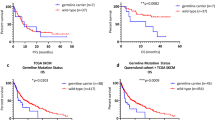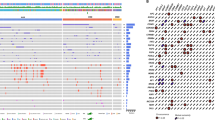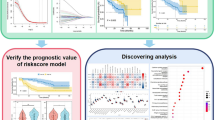Abstract
In familial cutaneous malignant melanoma (CMM), disruption of the retinoblastoma (pRB) pathway frequently occurs through inactivating mutations in the p16 (p16INK4A/CDKN2A/MTS1) gene or activating mutations in the G1-specific cyclin dependent kinase 4 gene (CDK4). Uveal malignant melanoma (UMM) also occurs in a familial setting, or sometimes in association with familial or sporadic CMM. Molecular studies of sporadic UMM have revealed somatic deletions covering the INK4A-ARF locus (encoding P16INK4Aand P14ARF) in a large proportion of tumours. We hypothesized that germline mutations in the p16INK4A, p14ARFor CDK4 genes might contribute to some cases of familial UMM, or to some cases of UMM associated with another melanoma. Out of 155 patients treated at the Institut Curie for UMM between 1994 and 1997, and interviewed about their personal and familial history of melanoma, we identified seven patients with a relative affected with UMM (n = 6) or CMM (n = 1), and two patients who have had, in addition to UMM, a personal history of second melanoma, UMM (n = 1), or CMM (n = 1). We screened by polymerase chain reaction single-strand conformation polymorphism the entire coding sequence of the INK4A-ARF locus (exon 1α from p16INK4A, exon 1β from p14ARF, and exons 2 and 3, common to both genes), as well as the exons 2, 5 and 8 of the CDK4 gene, coding for the functional domains involved in p16 and/or cyclin D1 binding. A previously reported polymorphism in exon 3 of the INK4A-ARF locus was found in one patient affected with bilateral UMM, but no germline mutations were detected, either in the p16INK4A, p14ARFor CDK4 genes. Our data support the involvement of other genes in predisposition to uveal melanoma. © 2000 Cancer Research Campaign
Similar content being viewed by others
Article PDF
Change history
16 November 2011
This paper was modified 12 months after initial publication to switch to Creative Commons licence terms, as noted at publication
References
Aitken J, Welch J, Duffy D, Milligan A, Green A, Martin N and Hayward N (1999) CDKN2A variants in a population-based sample of Queensland families with melanoma. J Natl Cancer Inst 91: 446–452
Bale SJ, Dracopoli NC, Tucker MA, Clark WH Jr, Fraser MC, Stanger BZ, Green P, Donis-Keller H, Housman DE and Greene MH (1989) Mapping the gene for hereditary cutaneous malignant melanoma-dysplastic nevus to chromosome 1p. N Engl J Med 320: 1367–1372
Bahuau M, Vidaud D, Jenkins RB, Bieche I, Kimmel DW, Assouline B, Smith JS, Alderete B, Cayuela JM, Harpey JP, Caille B and Vidaud M (1998) Germ-line deletion involving the INK4 locus in familial proneness to melanoma and nervous system tumours. Cancer Res 58: 2298–3003
Bataille V, Pinney E, Hungerford JL, Cuzick J, Bishop DT and Newton JA (1993) Five cases of coexistent primary ocular and cutaneous melanoma. Arch Dermatol 129: 198–201
Byeon IJ, Li J, Ericson K, Selby TL, Tevelev A, Kim HJ, O'Maille P and Tsai MD (1998) Tumour suppressor p16INK4A: determination of solution structure and analyses of its interaction with cyclin-dependent kinase 4. Mol Cell 1: 421–431
Canning CR and Hungerford J (1988) Familial uveal melanoma. Br J Ophthalmol 72: 241–243
Cannon-Albright LA, Goldgar DE, Meyer LJ, Lewis CM, Anderson DE, Fountain JW, Hegi ME, Wiseman RW, Petty EM, Bale AE, Olopade OI, Diaz MO, Kwiatkowski DJ, Piepkorn MW, Zone JJ and Skolnick MH (1992) Assignment of a locus for familial melanoma, MLM, to chromosome 9p13–p22. Science 258: 1148–1152
Chaubert P, Shaw P and Pillet N (1996) Informative MspI polymorphism adjacent to exon 3 of the p16INK4 (MTS1) gene. Mol Cell Probes 10: 467–468
Coleman KG, Wautlet BS, Morrissey D, Mulheron J, Sedman SA, Brinkley P, Price S and Webster K (1997) Identification of CDK4 sequences involved in cyclin D1 and p16 binding. J Biol Chem 272: 18869–18874
Dracopoli NC and Fountain JW (1996) CDKN2 mutations in melanoma. Cancer Surv 26: 115–132
Easton DF, Steele L, Fields P, Ormiston W, Averill D, Daly PA, McManus R, Neuhausen SL, Ford D, Wooster R, Cannon-Albright LA, Stratton MR and Goldgar D (1997) Cancer risks in two large breast cancer families linked to BRCA2 on chromosome 13q12–13. Am J Hum Genet 61: 120–128
Goldstein AM, Dracopoli NC, Ho EC, Fraser MC, Kearns KS, Bale SJ, McBride OW, Clark WH Jr and Tucker MA (1993) Further evidence for a locus for cutaneous malignant melanoma-dysplastic nevus (CMM/DN) on chromosome 1p, and evidence for genetic heterogeneity. Am J Hum Genet 52: 537–550
Kamb A, Shattuck-Eidens D, Eeles R, Liu Q, Gruis NA, Ding W, Hussey C, Tran T, Miki Y, Weaver-Feldhaus J, McClure M, Aitken JF, Anderson DE, Bergman, W Frants R, Goldgar DE, Green A, MacLennan R, Martin NG, Meyer LJ, Youl P, Zone JJ, Skolnick MH and Cannon-Albright LA (1994) Analysis of the p16 gene (CDKN2) as a candidate for the chromosome 9p melanoma susceptibility locus. Nat Genet 8: 22–26
Kamijo T, Weber JD, Zambetti G, Zindy F, Roussel MF and Sherr CJ (1998) Functional and physical interactions of the ARF tumour suppressor with p53 and Mdm2. Proc Natl Acad Sci USA 95: 8292–8297
Kumar R, Sauroja I, Punnonen K, Jansen C and Hemminki K (1998) Selective deletion of exon 1beta of the p19ARF gene in metastatic melanoma cell lines. Genes Chromosomes Cancer 23: 273–277
Liu L, Goldstein AM, Tucker MA, Brill H, Gruis NA, Hogg D and Lassam NJ (1997) Affected members of melanoma-prone families with linkage to 9p21 but lacking mutations in CDKN2A do not harbor mutations in the coding regions of either CDKN2B or p19ARF. Genes Chromosomes Cancer 19: 52–54
Liu L, Dilworth D, Gao L, Monzon J, Summers A, Lassam N and Hogg D (1999) Mutation of the CDKN2A 5′ UTR creates an aberrant initiation codon and predisposes to melanoma. Nat Genet 21: 128–132
Lynch HT, Anderson DE and Krush AJ (1968) Heredity and intraocular malignant melanoma. Study of two families and review of forty-five cases. Cancer 21: 119–125
Merbs SL and Sidransky D (1999) Analysis of p16 (CDKN2/MTS-1/INK4A) alterations in primary sporadic uveal melanoma. Invest Ophthalmol Vis Sci 40: 779–783
Mouriaux F, Casagrande F, Pillaire MJ, Manenti S, Malecaze F and Darbon JM (1998) Differential expression of G1 cyclins and cyclin-dependent kinase inhibitors in normal and transformed melanocytes. Invest Ophthalmol Vis Sci 39: 876–884
Newton Bishop JA, Bataille V, Pinney E and Bishop DT (1998) Family studies in melanoma: identification of the atypical mole syndrome (AMS) phenotype (1994). Melanoma Res 4: 199–206
Ohta M, Nagai H, Shimizu M, Rasio D, Berd D, Mastrangelo M, Singh AD, Shields JA, Shields CL and Croce CM (1994) Rarity of somatic and germ-line mutations of the cyclin-dependent kinase 4 inhibitor gene, CDK4I, in melanoma. Cancer Res 54: 5269–5272
Prescher G, Bornfeld N and Becher R (1994) Two subclones in a case of uveal melanoma: relevance of monosomy 3 and multiplication of chromosome 8q. Cancer Genet Cytogenet 77: 144–146
Puig S, Ruiz A, Lazaro C, Castel T, Lynch M, Palou J, Vilalta A, Weissenbach J, Mascaro JM and Estivill X (1995) Chromosome 9p deletions in cutaneous malignant melanoma tumours: the minimal deleted region involves markers outside the p16 (CDKN2) gene. Am J Hum Genet 57: 395–402
Serrano M, Hannon GJ and Beach D (1993) A new regulatory motif in cell-cycle control causing specific inhibition of cyclin D/CDK4. Nature 366: 704–707
Singh AD, Wang MX, Donoso LA, Shields CL, Potter PD, Shields JA, Elston RC and Fijal B (1996 a) Familial uveal melanoma, III. Is the occurrence of familial uveal melanoma coincidental?. Arch Ophthalmol 114: 1101–1104
Singh AD, Shields CL, De Potter P, Shields JA, Trock B, Cater J and Pastore D (1996 b) Familial uveal melanoma. Clinical observations on 56 patients. Arch Ophthalmol 114: 392–399
Singh AD, Croce CM, Wary KK, Shields JA, Donoso LA, Shields CL, Huebner K and Ohta M (1996 c) Familial uveal melanoma: absence of germ-line mutations involving the cyclin-dependent kinase-4 inhibitor gene (p16). Ophthalmic Genet 17: 39–40
Singh AD, Shields CL, Shields JA and De Potter P (1996 d) Bilateral primary uveal melanoma. Bad luck or bad genes?. Ophthalmology 103: 256–262
Singh AD, Wang MX, Donoso LA, Shields CL, De Potter P and Shields JA (1996 e) Genetic aspects of uveal melanoma: a brief review. Semin Oncol 23: 768–772
Sinilnikova OM, Egan KM, Quinn JL, Boutrand L, Lenoir GM, Stoppa-Lyonnet D, Desjardins L, Levy C, Goldgar D and Gragoudas ES (1999) Germ-line BRCA2 sequence variants in patients with ocular melanoma. Int J Cancer 82: 323–328
Speicher MR, Prescher G, du Manoir S, Jauch A, Horsthemke B, Bornfeld N, Becher R and Cremer T (1994) Chromosomal gains and losses in uveal melanomas detected by comparative genomic hybridization. Cancer Res 54: 3817–3823
Soufir N, Avril MF, Chompret A, Demenais F, Bombled J, Spatz A, Stoppa-Lyonnet D, Benard J and Bressac-de Paillerets B (1998) Prevalence of p16 and CDK4 germ-line mutations in 48 melanoma-prone families in France. The French Familial Melanoma Study Group. Hum Mol Genet 7: 209–216
Stott FJ, Bates S, James MC, McConnell BB, Starborg M, Brookes S, Palmero I, Ryan K, Hara E, Vousden KH and Peters G (1998) The alternative product from the human CDKN2A locus, p14(ARF), participates in a regulatory feedback loop with p53 and MDM2. EMBO J 17: 5001–5014
Tsao H, Benoit E, Sober AJ, Thiele C and Haluska FG (1998) Novel mutations in the p16/CDKN2A binding region of the cyclin-dependent kinase-4 gene. Cancer Res 58: 109–113
Van Hees CL, Jager MJ, Bleeker JC, Kemme H and Bergman W (1998) Occurrence of cutaneous and uveal melanoma in patients with uveal melanoma and their first-degree relatives. Melanoma Res 8: 175–180
Wang X, Egan KM, Gragoudas ES and Kelsey KT (1996) Constitutional alterations in p16 in patients with uveal melanoma. Melanoma Res 6: 405–410
Zuo L, Weger J, Yang Q, Goldstein AM, Tucker MA, Walker GJ, Hayward N and Dracopoli NC (1996) Germ-line mutations in the P16INK4a binding domain of CDK4 in familial melanoma. Nat Genet 12: 97–99
Author information
Authors and Affiliations
Rights and permissions
From twelve months after its original publication, this work is licensed under the Creative Commons Attribution-NonCommercial-Share Alike 3.0 Unported License. To view a copy of this license, visit http://creativecommons.org/licenses/by-nc-sa/3.0/
About this article
Cite this article
Soufir, N., Paillerets, Bd., Desjardins, L. et al. Individuals with presumably hereditary uveal melanoma do not harbour germline mutations in the coding regions of either the P16INK4A, P14ARF or cdk4 genes. Br J Cancer 82, 818–822 (2000). https://doi.org/10.1054/bjoc.1999.1005
Received:
Revised:
Accepted:
Published:
Issue date:
DOI: https://doi.org/10.1054/bjoc.1999.1005
Keywords
This article is cited by
-
Contribution of CDKN2A/P16 INK4A, P14 ARF, CDK4 and BRCA1/2 germline mutations in individuals with suspected genetic predisposition to uveal melanoma
Familial Cancer (2010)
-
Cancer family history characterization in an unselected cohort of 121 patients with uveal melanoma
Familial Cancer (2010)
-
Loss of nonclassical MHC molecules MIC-A/B expression during progression of uveal melanoma
British Journal of Cancer (2004)
-
Absence of BRAF gene mutations in uveal melanomas in contrast to cutaneous melanomas
British Journal of Cancer (2003)



